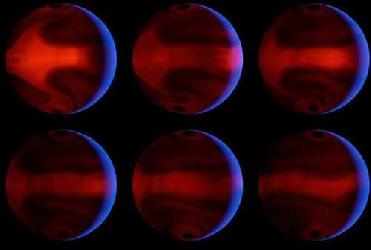
These computer-generated images chart the development of severe weather patterns on the highly eccentric exoplanet HD 80606b during the days after its closest approach to its parent star. NASA image
WASHINGTON (BNS): We mortals on earth are much worried when the temperature rises by a few degrees. But astronomers have now reported on an extra-solar planetary system where global warming is taken to a spectacular extreme: a 700-degree rise in a few hours.
The findings are published in the Nature magazine on January 29.
The planet, known as HD8606b, is a gas giant orbiting a star 200 light-years from Earth. Its extremely eccentric orbit around the star takes it from a relatively comfortable distance approximating the Earth’s orbit, to the blazing hot regions much closer than Mercury is to the Sun. Infrared sensors aboard NASA's Spitzer Space Telescope measured the planet's temperature as it swooped close to the star, observing a planetary heat wave that rose from 800 to 1,500 degrees Kelvin (980 to 2,240 degrees Fahrenheit) in just six hours, the astronomers said.
According to scientists, this planet can be witnessed on February 14, 2009, when it is expected to pass in front of its star and possibly transit the star. HD8606b has an estimated mass of about four times that of Jupiter and completes its orbit in about 111 days. At its closest approach to the star it experiences radiation about 800 times stronger than when it is most distant, the astronomers said.
Lead author Greg Laughlin of the Lick Observatory, University of California at Santa Cruz said that this is the first time that we've detected weather changes in real time on a planet outside the solar system. “The results are very exciting because they give us important clues to the atmospheric properties of the planet,” Laughlin said.
At the closest point, the sunlight beating down on the planet is 825 times stronger than the irradiation it receives at its farthest point from the star. “If you could float above the clouds of this planet, you'd see its sun growing larger and larger at faster and faster rates, increasing in brightness by almost a factor of 1,000,” Laughlin said.
According to the scientist, Spitzer observed the planet for 30 hours before, during, and just after its closest approach to the star. The planet passed behind the star (an event called a secondary eclipse) just before the moment of its closest approach. This was a lucky break for Laughlin and his colleagues, who had not known that it would happen when they planned the observation. The secondary eclipse allowed them to get accurate measurements from just the star and thereby determine exact temperatures for the planet.
“The extreme temperature swing observed by Spitzer indicates that the intense irradiation from the star is absorbed in a layer of the planet's upper atmosphere that absorbs and loses heat rapidly,” Laughlin said.
Paul Butler of the Carnegie Institution for Science's Department of Terrestrial Magnetism said that even after finding nearly 200 planets, the diversity and oddness of these new worlds continues to amaze and confound him. Butler made the precision velocity measurements of the host star that allowed the planet's orbit to be calculated. He has uncovered about half of the known extra-solar planets.
Co-author Jonathan Langton, a postdoctoral researcher at UCSC, fed the Spitzer data into a hydrodynamic model of the planet's atmosphere to predict its response to the intense heating. Langton's simulation shows the global storms and shockwaves unleashed in the planet's atmosphere every 111 days as it swings close to its star.
Langton said that the initial response could be described as an explosion on the side facing the star. “As the atmosphere heats up and expands, it produces very high winds, on the order of 5 km per second, flowing away from the day side toward the night side. The rotation of the planet causes these winds to curl up into large-scale storm systems that gradually die down as the planet cools over the course of its orbit,” Langton said.
Daniel Kasen, a Hubble postdoctoral fellow at UCSC, was able to generate photorealistic images of the planet using a programme he developed to calculate radiative transfer processes in astrophysics. “It calculates the colour and intensity of light coming from the glowing planet, and also how starlight would reflect off the surface of the planet,” Kasen said.
Meanwhile, the astronomers said that the resulting images show a thin blue crescent of reflected starlight framing the night side of the planet, which glows cherry red from its own heat, like coals in a fire. “These images are far more realistic than anything that's been done before for extra-solar planets,” Laughlin said.
A Swiss planet-hunting team led by Dominique Naef of the Geneva Observatory, Switzerland, discovered HD 80606b in 2001. They used a method known as the Doppler-velocity technique, to detect the telltale wobble in the light from the star caused by the gravitational tug of the planet, the astronomers said.
 Previous Article
Previous Article Next Article
Next Article













The Indian Air Force, in its flight trials evaluation report submitted before the Defence Ministry l..
view articleAn insight into the Medium Multi-Role Combat Aircraft competition...
view articleSky enthusiasts can now spot the International Space Station (ISS) commanded by Indian-American astr..
view article